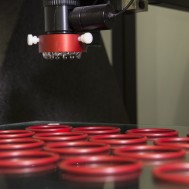To minimize the effects of frictional forces on your o-ring seal and avoid harmful abrasion, proper lubrication is recommended. While lubrication is important throughout the lifespan of your o-ring, the greatest benefits are seen during installation.
There are a variety of different lubricants that are used for o-ring installation, including greases and oils. Additionally, every rubber material requires a specific lubricant that is chemically compatible. Here’s a closer look at how to choose and apply the best lubricant for your rubber o-ring.
Three Types of Lubricants
When it comes to o-ring lubricants, there are three general types that rely on the timing of when it’s applied to the rubber in order to be effective:
- Internal lubricant: This lubricant is mixed into the elastomer before molding. Since it is dispersed evenly throughout the rubber before vulcanization, it lowers the coefficient of friction of the entire rubber part. Some internal lubricants bloom to the surface coating the rubber.
- Temporary external lubricant: This lubricant is typically a liquid that is applied to the surface of the molded part and can be removed by specific fluids or solvents. Temporary external lubricants greatly reduce the risk of abrasion, pinching and cutting during installation and assembly.
- Semi-permanent lubricant coatings: Coatings can be applied by dipping, vapor disposition or spraying. Some coatings can peel or flake over time and possibly cause contamination issues. Other coatings are baked on or chemically alter the surface of the rubber and have to be worn away to remove.
Apple rubber now provides more coatings for rubber parts. In the past, the industry often used Teflon as a coating, however Teflon is known to flake off. To avoid cracks and flakiness, Apple Rubber uses higher quality coating materials.
What to Consider When Choosing Your Lubricant
Depending on your application, there specific characteristics of every lubricant that will have an impact on your seal. The important characteristics to keep in mind include:
- Temperature: Just as o-ring materials perform better at specific temperatures, lubricants work the same. Low flash point greases or oils become volatilized at higher temperatures. Make sure your lubricant can function at the temperature range of your application.
- Stability: A lubricant should not become harder or softer when introduced to friction
- Water resistance: Some lubricants are resistant to water and are a good option for water applications while others are not. Make sure your lubricant will not be affected by fluids that may be present in your application.
- Chemical compatibility: Make sure your lubricant is compatible with your sealing material. Visit our Chemical Compatibility Guide to find out which materials pair best with specific products. Incompatible lubricants can swell the rubber, causing higher squeeze values and require more force to push or spin.
- Regulatory: Make sure the lubricant has the proper regulatory use. Each industry has their own regulations. For example, potable water (NSF), food grade (FDA) and medical (USP or ISO).
How to Apply Lubrication to Your O-Ring
When applying any type of lubrication to your o-ring, the goal is to achieve a thin uniform layer to the entire surface. In the case of internal lubricants, it’s still important that the lubricant is thin and consistently applied throughout the seal to ensure the lubricant protects the seal effectively. This will help ease installation and reduce the effects of friction as much as possible.
When applying external o-ring lubrication, there are a few popular methods:
- Applying the lubricant with your hands or a brush and ensure the o-ring is evenly coated
- Dipping the o-ring directly into the lubricant to fully coat the exterior of the seal
- Dispensing the lubricant into the seal packaging and shaking it until the o-ring is evenly coated
Apple Rubber offers an O-Ring Lubricant Guide that will help you choose the best lubricant for your application. This guide will provide you with common elastomers, typical applications they are used in and which lubricants are the optimum choice.
Have questions about which lubrication will work best for your o-ring?
Ask an engineer today.
